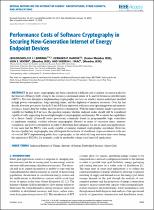 ResearchSpace
ResearchSpace
Performance costs of cryptography in securing new-generation Internet of Energy endpoint devices
JavaScript is disabled for your browser. Some features of this site may not work without it.
- ResearchSpace
- →
- Research Publications/Outputs
- →
- Journal Articles
- →
- View Item
| dc.contributor.author |
Ledwaba, Lehlogonolo PI

|
|
| dc.contributor.author |
Hancke, GP

|
|
| dc.contributor.author |
Venter, HS

|
|
| dc.contributor.author |
Isaac, Sherrin J

|
|
| dc.date.accessioned | 2018-05-14T12:15:43Z | |
| dc.date.available | 2018-05-14T12:15:43Z | |
| dc.date.issued | 2018-01 | |
| dc.identifier.citation | Ledwaba, L.P.I. et al. 2018. Performance costs of cryptography in securing new-generation Internet of Energy endpoint devices. IEEE Access, vol. 6: 9303-9323 | en_US |
| dc.identifier.issn | 2169-3536 | |
| dc.identifier.uri | http://ieeexplore.ieee.org/document/8258990/ | |
| dc.identifier.uri | DOI: 10.1109/ACCESS.2018.2793301 | |
| dc.identifier.uri | http://hdl.handle.net/10204/10203 | |
| dc.description | This is an open access article. | en_US |
| dc.description.abstract | In past years, cryptography has been considered a difficult task to achieve on sensor nodes for the Internet of Energy (IoE) owing to the resource-constrained nature of 8-bit and 16-bit microcontroller units (MCUs). Previous attempts at implementing cryptographic services on wireless sensor nodes have resulted in high power consumptions, long operating times and the depletion of memory resources. Over the last decade, however, processors for the IoT and IoE have improved; with increased operating power and memory resources, longer data bus widths and low power consumption. With the improvements made to processors suitable for building IoT devices, the question remains whether endpoint nodes should still be considered capable of only supporting the most lightweight of cryptographic mechanisms. We evaluate the capabilities of a device family (Cortex-M series processors) commonly found in programmable logic controllers (PLC) to implement standard, verified software cryptographic libraries in terms of execution times, memory occupation and power consumption in order to determine their adequacy for use in smart grid applications. It was seen that the MCUs were easily capable of running standard cryptographic algorithms. However, the use of public key cryptography may still require the inclusion of a hardware crypto accelerator or the use of a secure MCU implementing public key cryptography; as the relatively long execution times seen during the operation of, for example, ECDSA could be intolerable within a real time, IoE application. | en_US |
| dc.language.iso | en | en_US |
| dc.publisher | IEEE | en_US |
| dc.relation.ispartofseries | Worklist;19996 | |
| dc.subject | Industrial Internet of Things | en_US |
| dc.subject | Internet of Energy | en_US |
| dc.subject | Embedded security | en_US |
| dc.subject | Smart grid | en_US |
| dc.title | Performance costs of cryptography in securing new-generation Internet of Energy endpoint devices | en_US |
| dc.type | Article | en_US |
| dc.identifier.apacitation | Ledwaba, L. P., Hancke, G., Venter, H., & Isaac, S. J. (2018). Performance costs of cryptography in securing new-generation Internet of Energy endpoint devices. http://hdl.handle.net/10204/10203 | en_ZA |
| dc.identifier.chicagocitation | Ledwaba, Lehlogonolo PI, GP Hancke, HS Venter, and Sherrin J Isaac "Performance costs of cryptography in securing new-generation Internet of Energy endpoint devices." (2018) http://hdl.handle.net/10204/10203 | en_ZA |
| dc.identifier.vancouvercitation | Ledwaba LP, Hancke G, Venter H, Isaac SJ. Performance costs of cryptography in securing new-generation Internet of Energy endpoint devices. 2018; http://hdl.handle.net/10204/10203. | en_ZA |
| dc.identifier.ris | TY - Article AU - Ledwaba, Lehlogonolo PI AU - Hancke, GP AU - Venter, HS AU - Isaac, Sherrin J AB - In past years, cryptography has been considered a difficult task to achieve on sensor nodes for the Internet of Energy (IoE) owing to the resource-constrained nature of 8-bit and 16-bit microcontroller units (MCUs). Previous attempts at implementing cryptographic services on wireless sensor nodes have resulted in high power consumptions, long operating times and the depletion of memory resources. Over the last decade, however, processors for the IoT and IoE have improved; with increased operating power and memory resources, longer data bus widths and low power consumption. With the improvements made to processors suitable for building IoT devices, the question remains whether endpoint nodes should still be considered capable of only supporting the most lightweight of cryptographic mechanisms. We evaluate the capabilities of a device family (Cortex-M series processors) commonly found in programmable logic controllers (PLC) to implement standard, verified software cryptographic libraries in terms of execution times, memory occupation and power consumption in order to determine their adequacy for use in smart grid applications. It was seen that the MCUs were easily capable of running standard cryptographic algorithms. However, the use of public key cryptography may still require the inclusion of a hardware crypto accelerator or the use of a secure MCU implementing public key cryptography; as the relatively long execution times seen during the operation of, for example, ECDSA could be intolerable within a real time, IoE application. DA - 2018-01 DB - ResearchSpace DP - CSIR KW - Industrial Internet of Things KW - Internet of Energy KW - Embedded security KW - Smart grid LK - https://researchspace.csir.co.za PY - 2018 SM - 2169-3536 T1 - Performance costs of cryptography in securing new-generation Internet of Energy endpoint devices TI - Performance costs of cryptography in securing new-generation Internet of Energy endpoint devices UR - http://hdl.handle.net/10204/10203 ER - | en_ZA |





